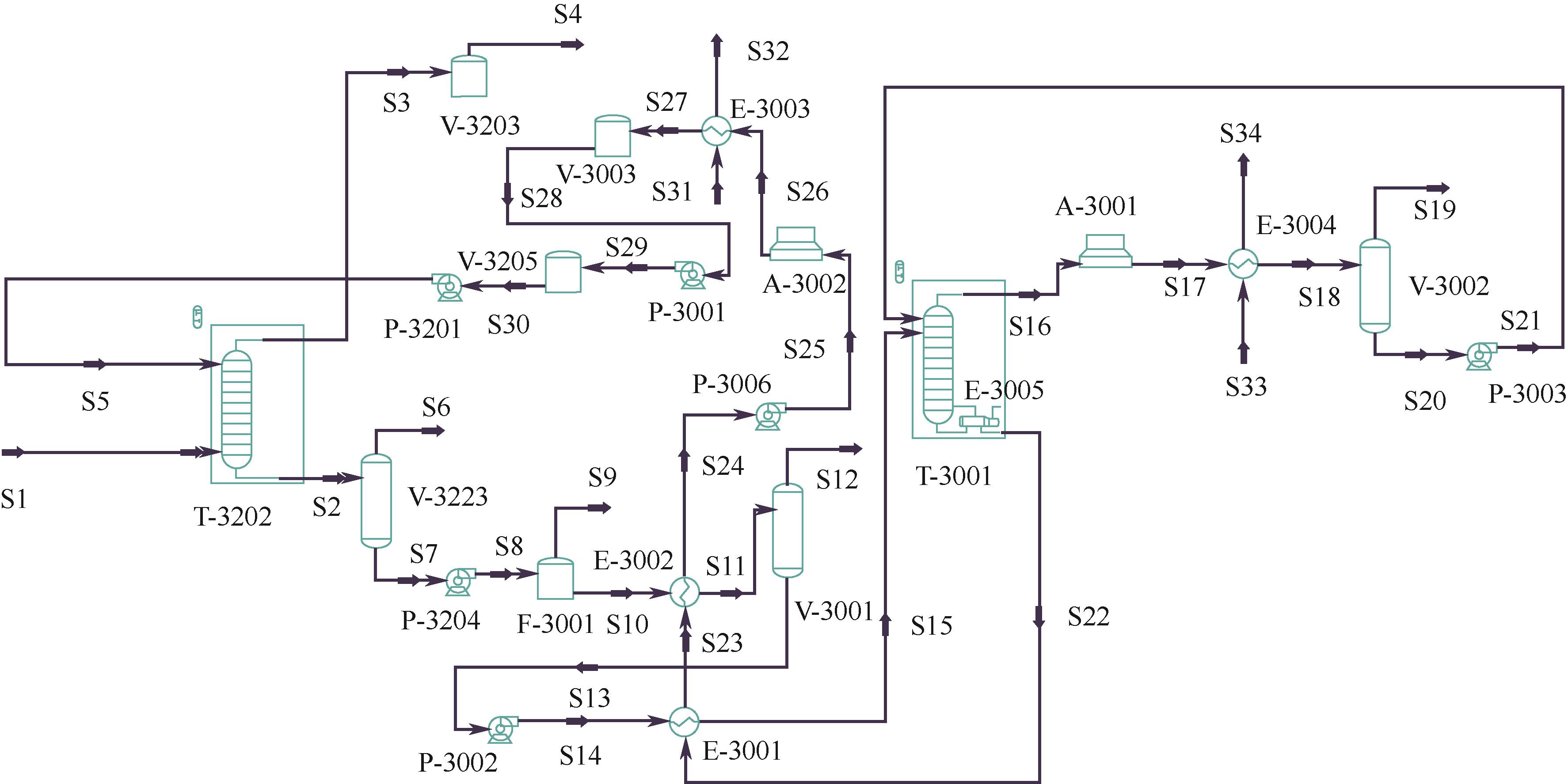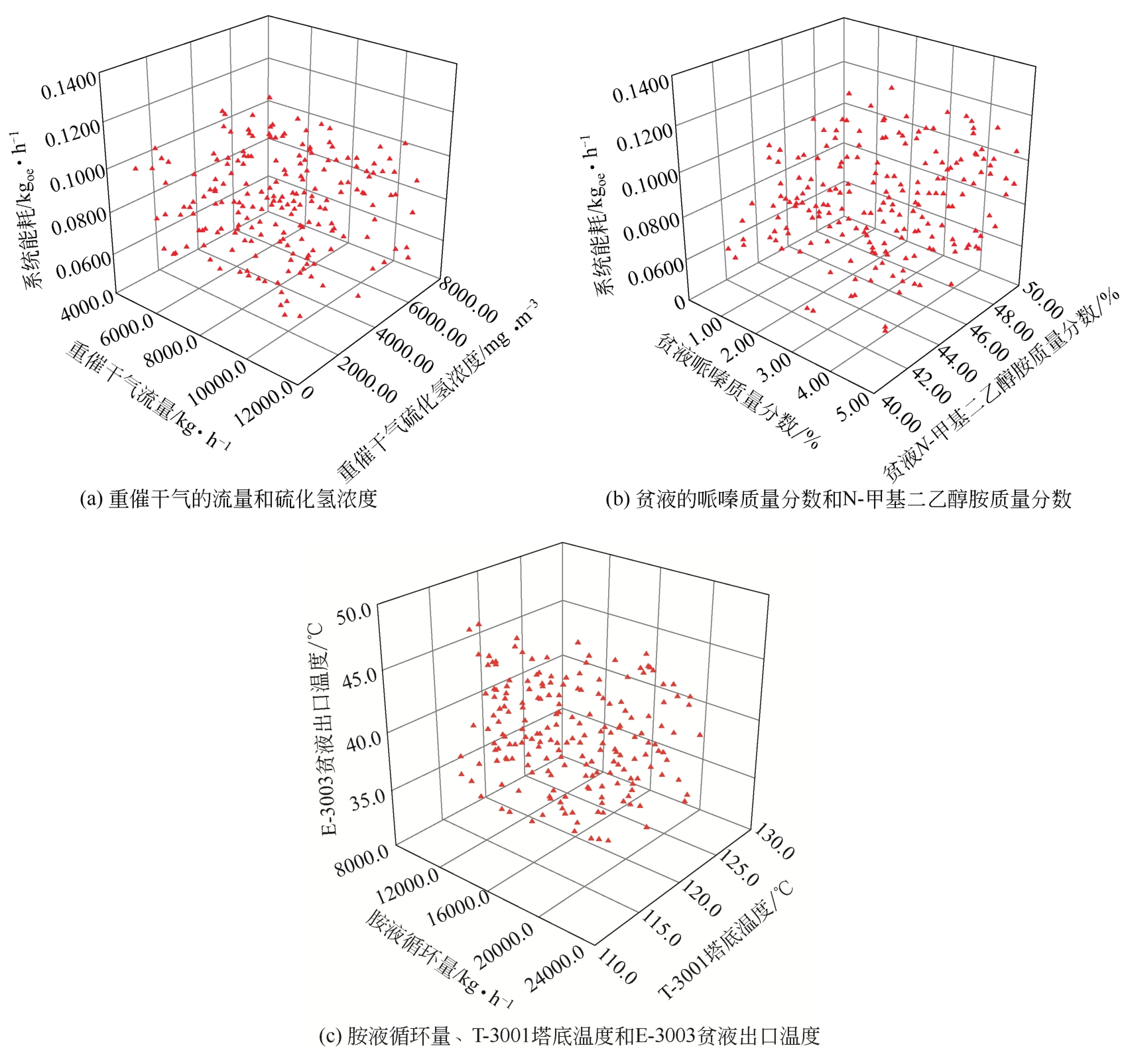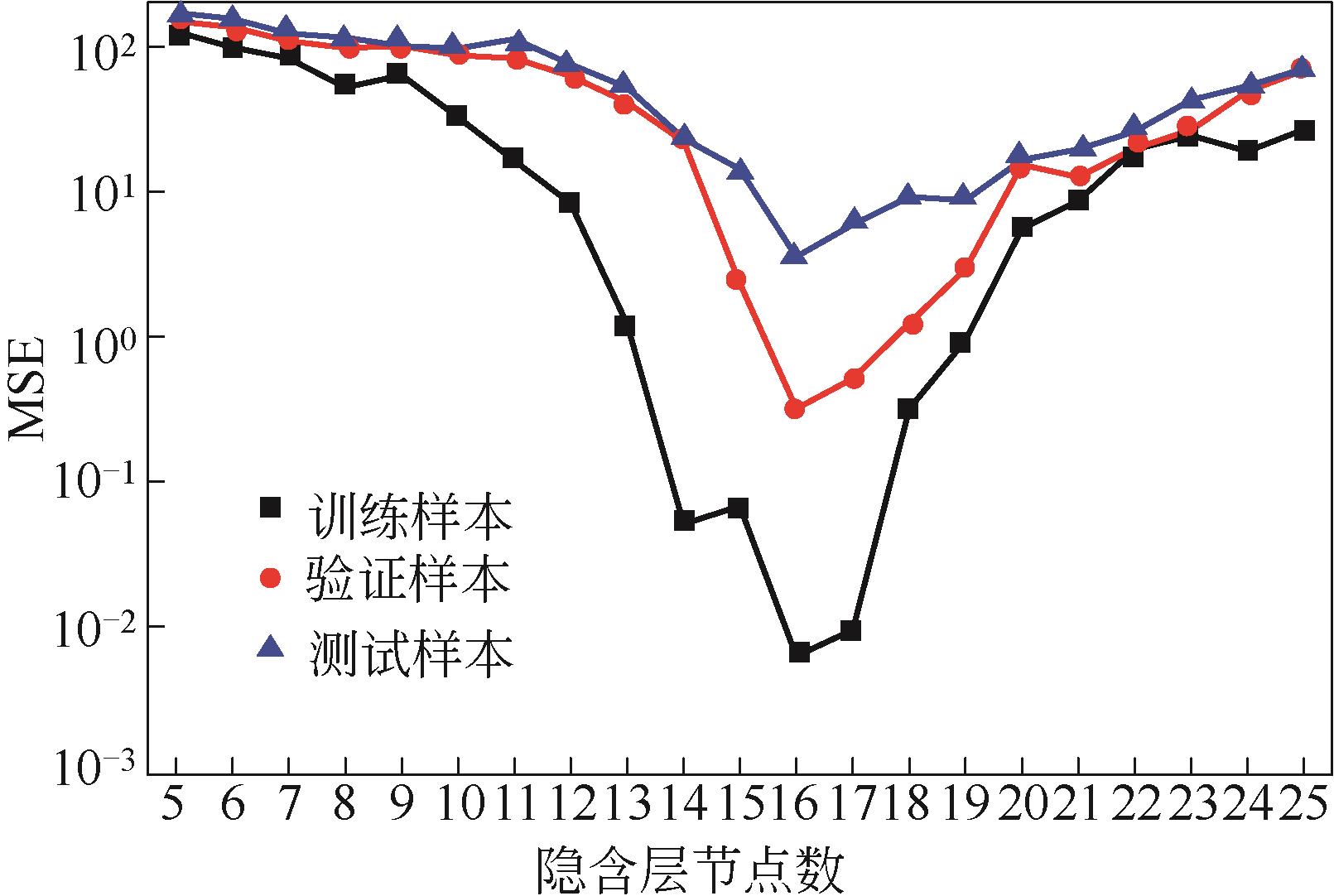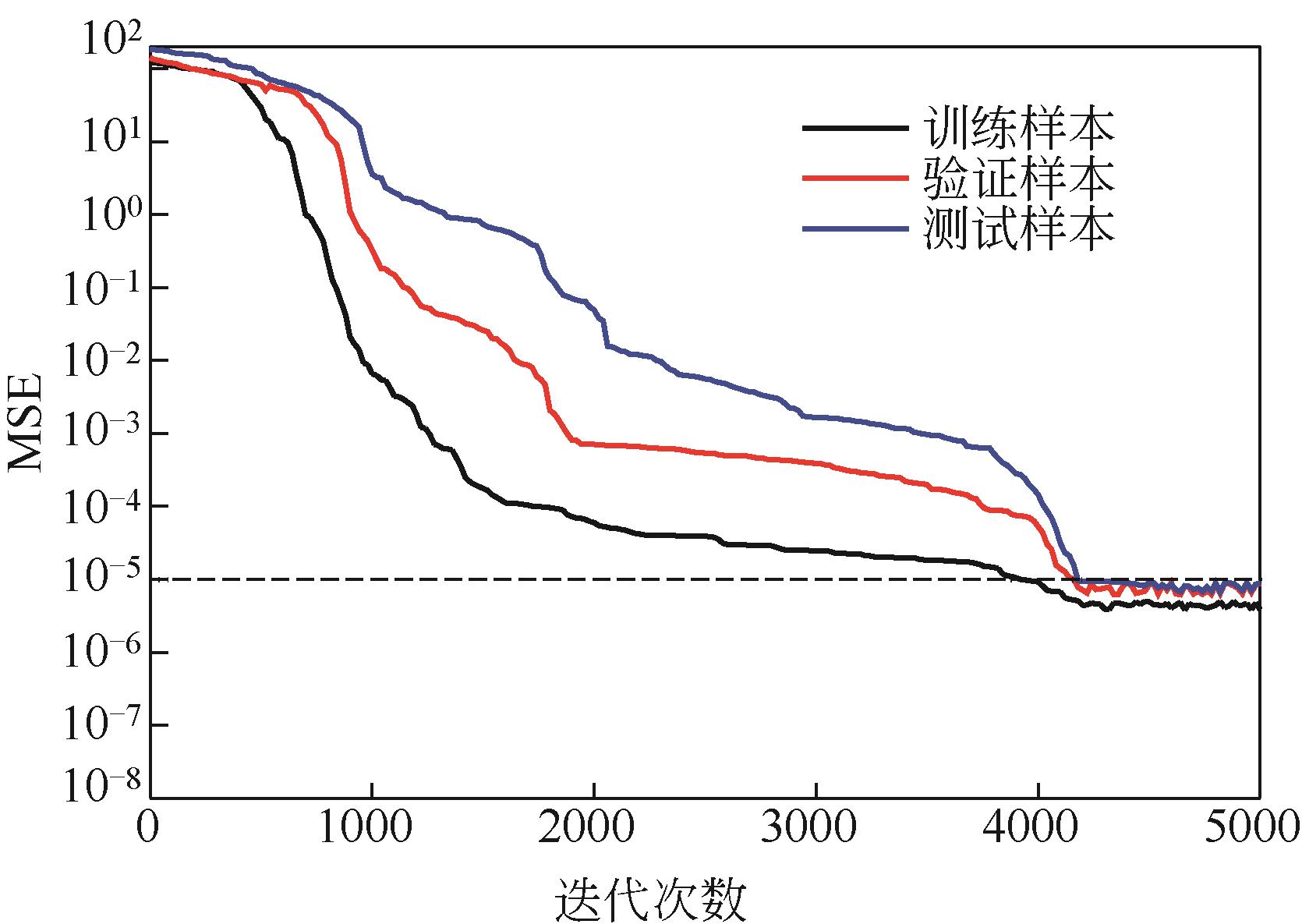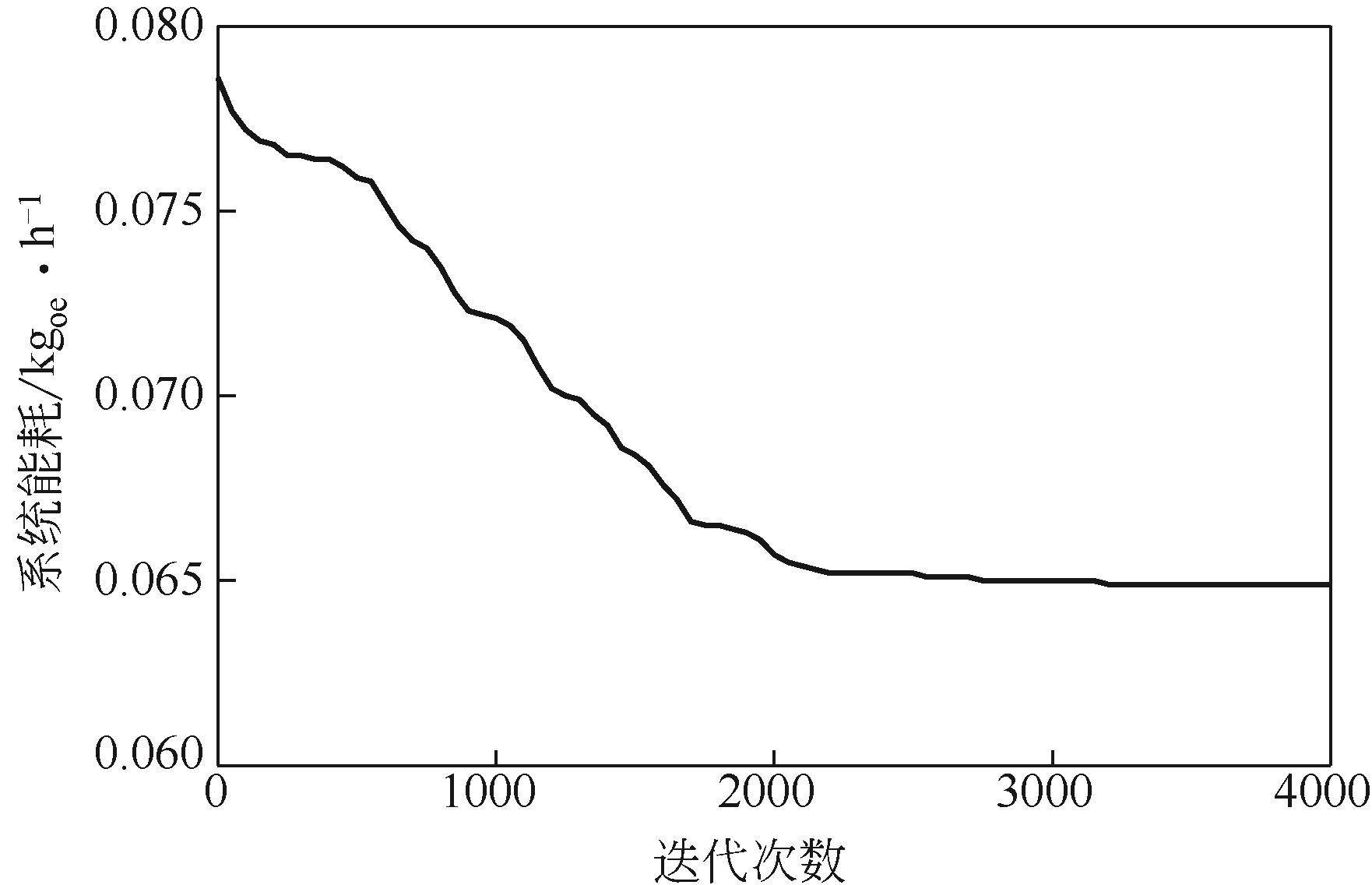化工进展 ›› 2021, Vol. 40 ›› Issue (6): 3107-3118.DOI: 10.16085/j.issn.1000-6613.2020-1426
利用基于PSO算法的径向基人工神经网络优化重催干气脱硫
范峥1( ), 田润芝1, 林亮2, 韩彦忠3, 郭阳3, 豆龙龙3, 景根辉1, TYOOR Agi Damian1
), 田润芝1, 林亮2, 韩彦忠3, 郭阳3, 豆龙龙3, 景根辉1, TYOOR Agi Damian1
- 1.西安石油大学化学化工学院,陕西 西安 710065
2.西安长庆科技工程有限责任公司,陕西 西安 710018
3.中国石油长庆油田分公司第十采油厂,甘肃 庆阳 745000
-
收稿日期:2020-07-23修回日期:2020-10-11出版日期:2021-06-06发布日期:2021-06-22 -
通讯作者:范峥 -
作者简介:范峥(1982—),男,博士,副教授,研究方向为石油天然气化工过程人工智能优化。E-mail:fanzheng@xsyu.edu.cn 。 -
基金资助:中国国家留学基金(201908610135);西安石油大学研究生创新与实践能力培养项目(YCS19212062)
Desulfurization optimization of reforming catalytic dry gas using radial basis artificial neural network based on PSO algorithm
FAN Zheng1( ), TIAN Runzhi1, LIN Liang2, HAN Yanzhong3, GUO Yang3, DOU Longlong3, JING Genhui1, TYOOR Agi Damian1
), TIAN Runzhi1, LIN Liang2, HAN Yanzhong3, GUO Yang3, DOU Longlong3, JING Genhui1, TYOOR Agi Damian1
- 1.College of Chemistry & Chemical Engineering, Xi’an Shiyou University, Xi’an 710065, Shaanxi, China
2.Xi’an Changqing Technology Engineering Company Limited, Xi’an 710018, Shaanxi, China
3.The 10th Oil Production Plant of Changqing Oilfield Branch Company, China National Petroleum Corporation, Qingyang 745400, Gansu, China
-
Received:2020-07-23Revised:2020-10-11Online:2021-06-06Published:2021-06-22 -
Contact:FAN Zheng
摘要:
针对重催干气脱硫过程存在进料波动频繁、优化响应滞后导致能量消耗过大等问题,通过Aspen HYSYS V11软件利用Li-Mather物性方法对该系统进行全流程模拟,根据Plackett-Burman设计筛选对目标值具有显著影响的有效因素,利用基于PSO算法的径向基人工神经网络对预测模型进行训练、验证和测试,并在满足净化干气硫化氢浓度约束的前提下对其进行深度优化,以期最小化系统能耗。结果表明,重催干气流量、重催干气硫化氢浓度、贫液哌嗪质量分数、贫液N-甲基二乙醇胺(MDEA)质量分数、胺液循环量、T-3001塔底温度和E-3003贫液出口温度对系统能耗影响非常显著,当以上述因素为输入信号,以系统能耗为网络输出时,7-16-1型径向基人工神经网络预测模型经过4182次迭代后,它的训练样本、验证样本、测试样本均方误差分别为5.08×10-6、7.78×10-6和9.56×10-6,均小于容许收敛误差限10-5,而其决定系数亦高达0.981、0.975、0.969,表现出良好的相关性。当利用基于PSO算法的径向基人工神经网络对重催干气脱硫系统能耗进行优化时,经过3198次粒子进化迭代后系统能耗仅为0.0649kgoe/h,较优化前系统能耗0.0713kgoe/h降低了8.98%,节能效果显著。
中图分类号:
引用本文
范峥, 田润芝, 林亮, 韩彦忠, 郭阳, 豆龙龙, 景根辉, TYOOR Agi Damian. 利用基于PSO算法的径向基人工神经网络优化重催干气脱硫[J]. 化工进展, 2021, 40(6): 3107-3118.
FAN Zheng, TIAN Runzhi, LIN Liang, HAN Yanzhong, GUO Yang, DOU Longlong, JING Genhui, TYOOR Agi Damian. Desulfurization optimization of reforming catalytic dry gas using radial basis artificial neural network based on PSO algorithm[J]. Chemical Industry and Engineering Progress, 2021, 40(6): 3107-3118.
| 项目 | 单位 | 模拟值 | 实际值 |
|---|---|---|---|
| 重催干气 | |||
| 流量 | kg·h-1 | 6701.0 | 6701.0 |
| 硫化氢浓度 | mg·m-3 | 1716.15 | 1716.15 |
| 二氧化碳体积分数 | % | 4.24 | 4.24 |
| 压力 | MPa(表) | 0.920 | 0.920 |
| 温度 | ℃ | 31.3 | 31.3 |
| 贫液 | |||
| 哌嗪质量分数 | % | 2.87 | 2.79 |
| N-甲基二乙醇胺质量分数 | % | 44.96 | 45.03 |
| 操作参数 | |||
| 胺液循环量 | kg·h-1 | 14500.0 | 14500.0 |
| V-3223压力 | MPa(表) | 0.900 | 0.900 |
| V-3223闪蒸气量 | m3·h-1 | 35.6 | 35.2 |
| E-3002富液进口温度 | ℃ | 40.3 | 40.7 |
| E-3002富液出口温度 | ℃ | 65.2 | 65.5 |
| E-3001富液出口温度 | ℃ | 98.0 | 97.7 |
| T-3001塔底压力 | MPa(表) | 0.092 | 0.092 |
| T-3001塔底温度 | ℃ | 122.1 | 121.1 |
| E-3001贫液出口温度 | ℃ | 95.2 | 94.8 |
| E-3002贫液出口温度 | ℃ | 71.1 | 70.8 |
| A-3002贫液出口温度 | ℃ | 50.5 | 50.5 |
| E-3003贫液出口温度 | ℃ | 39.6 | 40.0 |
| 贫液返塔压力 | MPa(表) | 0.985 | 0.985 |
| 酸气压力 | MPa(表) | 0.054 | 0.052 |
| 酸气量 | m3·h-1 | 2385.0 | 2364.2 |
| 酸液回流量 | kg·h-1 | 2.451 | 2.396 |
| A-3001酸气进口温度 | ℃ | 100.0 | 99.4 |
| A-3001酸气出口温度 | ℃ | 56.2 | 55.8 |
| E-3004酸气出口温度 | ℃ | 42.8 | 43.0 |
| 净化干气 | |||
| 流量 | kg·h-1 | 6699.4 | 6682.7 |
| 硫化氢含量 | mg·m-3 | 13.13 | 14.52 |
| 二氧化碳体积分数 | % | 1.86 | 1.88 |
| 压力 | MPa(表) | 0.850 | 0.853 |
| 温度 | ℃ | 38.9 | 39.2 |
表1 重催干气脱硫系统流程模拟结果
| 项目 | 单位 | 模拟值 | 实际值 |
|---|---|---|---|
| 重催干气 | |||
| 流量 | kg·h-1 | 6701.0 | 6701.0 |
| 硫化氢浓度 | mg·m-3 | 1716.15 | 1716.15 |
| 二氧化碳体积分数 | % | 4.24 | 4.24 |
| 压力 | MPa(表) | 0.920 | 0.920 |
| 温度 | ℃ | 31.3 | 31.3 |
| 贫液 | |||
| 哌嗪质量分数 | % | 2.87 | 2.79 |
| N-甲基二乙醇胺质量分数 | % | 44.96 | 45.03 |
| 操作参数 | |||
| 胺液循环量 | kg·h-1 | 14500.0 | 14500.0 |
| V-3223压力 | MPa(表) | 0.900 | 0.900 |
| V-3223闪蒸气量 | m3·h-1 | 35.6 | 35.2 |
| E-3002富液进口温度 | ℃ | 40.3 | 40.7 |
| E-3002富液出口温度 | ℃ | 65.2 | 65.5 |
| E-3001富液出口温度 | ℃ | 98.0 | 97.7 |
| T-3001塔底压力 | MPa(表) | 0.092 | 0.092 |
| T-3001塔底温度 | ℃ | 122.1 | 121.1 |
| E-3001贫液出口温度 | ℃ | 95.2 | 94.8 |
| E-3002贫液出口温度 | ℃ | 71.1 | 70.8 |
| A-3002贫液出口温度 | ℃ | 50.5 | 50.5 |
| E-3003贫液出口温度 | ℃ | 39.6 | 40.0 |
| 贫液返塔压力 | MPa(表) | 0.985 | 0.985 |
| 酸气压力 | MPa(表) | 0.054 | 0.052 |
| 酸气量 | m3·h-1 | 2385.0 | 2364.2 |
| 酸液回流量 | kg·h-1 | 2.451 | 2.396 |
| A-3001酸气进口温度 | ℃ | 100.0 | 99.4 |
| A-3001酸气出口温度 | ℃ | 56.2 | 55.8 |
| E-3004酸气出口温度 | ℃ | 42.8 | 43.0 |
| 净化干气 | |||
| 流量 | kg·h-1 | 6699.4 | 6682.7 |
| 硫化氢含量 | mg·m-3 | 13.13 | 14.52 |
| 二氧化碳体积分数 | % | 1.86 | 1.88 |
| 压力 | MPa(表) | 0.850 | 0.853 |
| 温度 | ℃ | 38.9 | 39.2 |
| 因素 | 单位 | 低水平(-1) | 高水平 (1) |
|---|---|---|---|
| A(重催干气流量) | kg·h-1 | 4600.0 | 12000.0 |
| B(重催干气硫化氢浓度) | mg·m-3 | 200.00 | 7000.00 |
| C(贫液哌嗪质量分数) | % | 1.00 | 5.00 |
| D(贫液N-甲基二乙醇胺质量分数) | % | 40.00 | 50.00 |
| E(胺液循环量) | kg·h-1 | 8000.0 | 23000.0 |
| F(T-3001塔底温度) | ℃ | 115.0 | 125.0 |
| G(E-3003贫液出口温度) | ℃ | 32.0 | 46.0 |
表2 Plackett-Burman设计因素水平一览表
| 因素 | 单位 | 低水平(-1) | 高水平 (1) |
|---|---|---|---|
| A(重催干气流量) | kg·h-1 | 4600.0 | 12000.0 |
| B(重催干气硫化氢浓度) | mg·m-3 | 200.00 | 7000.00 |
| C(贫液哌嗪质量分数) | % | 1.00 | 5.00 |
| D(贫液N-甲基二乙醇胺质量分数) | % | 40.00 | 50.00 |
| E(胺液循环量) | kg·h-1 | 8000.0 | 23000.0 |
| F(T-3001塔底温度) | ℃ | 115.0 | 125.0 |
| G(E-3003贫液出口温度) | ℃ | 32.0 | 46.0 |
| 序号 | A/kg·h-1 | B/mg·m-3 | C/% | D/% | E/kg·h-1 | F/℃ | G/℃ | ψ/kgoe·h-1 |
|---|---|---|---|---|---|---|---|---|
| 1 | 12000.0 | 7000.00 | 1.00 | 50.00 | 23000.0 | 115.0 | 46.0 | 0.0793 |
| 2 | 4600.0 | 200.00 | 1.00 | 50.00 | 23000.0 | 125.0 | 32.0 | 0.0877 |
| 3 | 12000.0 | 200.00 | 5.00 | 50.00 | 8000.0 | 125.0 | 32.0 | 0.0883 |
| 4 | 12000.0 | 200.00 | 1.00 | 40.00 | 23000.0 | 125.0 | 46.0 | 0.0826 |
| 5 | 12000.0 | 7000.00 | 5.00 | 40.00 | 23000.0 | 125.0 | 32.0 | 0.0873 |
| 6 | 4600.0 | 200.00 | 5.00 | 50.00 | 23000.0 | 115.0 | 46.0 | 0.0814 |
| 7 | 12000.0 | 7000.00 | 1.00 | 50.00 | 8000.0 | 115.0 | 32.0 | 0.0873 |
| 8 | 4600.0 | 7000.00 | 1.00 | 40.00 | 8000.0 | 125.0 | 46.0 | 0.0849 |
| 9 | 4600.0 | 200.00 | 1.00 | 40.00 | 8000.0 | 115.0 | 32.0 | 0.0918 |
| 10 | 4600.0 | 7000.00 | 5.00 | 50.00 | 8000.0 | 125.0 | 46.0 | 0.0825 |
| 11 | 12000.0 | 200.00 | 5.00 | 40.00 | 8000.0 | 115.0 | 46.0 | 0.0844 |
| 12 | 4600.0 | 7000.00 | 5.00 | 40.00 | 23000.0 | 115.0 | 32.0 | 0.0884 |
表3 Plackett-Burman设计实验方案一览表
| 序号 | A/kg·h-1 | B/mg·m-3 | C/% | D/% | E/kg·h-1 | F/℃ | G/℃ | ψ/kgoe·h-1 |
|---|---|---|---|---|---|---|---|---|
| 1 | 12000.0 | 7000.00 | 1.00 | 50.00 | 23000.0 | 115.0 | 46.0 | 0.0793 |
| 2 | 4600.0 | 200.00 | 1.00 | 50.00 | 23000.0 | 125.0 | 32.0 | 0.0877 |
| 3 | 12000.0 | 200.00 | 5.00 | 50.00 | 8000.0 | 125.0 | 32.0 | 0.0883 |
| 4 | 12000.0 | 200.00 | 1.00 | 40.00 | 23000.0 | 125.0 | 46.0 | 0.0826 |
| 5 | 12000.0 | 7000.00 | 5.00 | 40.00 | 23000.0 | 125.0 | 32.0 | 0.0873 |
| 6 | 4600.0 | 200.00 | 5.00 | 50.00 | 23000.0 | 115.0 | 46.0 | 0.0814 |
| 7 | 12000.0 | 7000.00 | 1.00 | 50.00 | 8000.0 | 115.0 | 32.0 | 0.0873 |
| 8 | 4600.0 | 7000.00 | 1.00 | 40.00 | 8000.0 | 125.0 | 46.0 | 0.0849 |
| 9 | 4600.0 | 200.00 | 1.00 | 40.00 | 8000.0 | 115.0 | 32.0 | 0.0918 |
| 10 | 4600.0 | 7000.00 | 5.00 | 50.00 | 8000.0 | 125.0 | 46.0 | 0.0825 |
| 11 | 12000.0 | 200.00 | 5.00 | 40.00 | 8000.0 | 115.0 | 46.0 | 0.0844 |
| 12 | 4600.0 | 7000.00 | 5.00 | 40.00 | 23000.0 | 115.0 | 32.0 | 0.0884 |
| 名称 | 平方和 | 自由度 | 均方 | F值 | P值 |
|---|---|---|---|---|---|
| 合计 | 1.44×10-4 | 11 | |||
| A | 5.42×10-6 | 1 | 5.42×10-6 | 5628.24 | 1.8919×10-7 |
| B | 4.17×10-6 | 1 | 4.17×10-6 | 4330.22 | 3.1949×10-7 |
| C | 2.68×10-7 | 1 | 2.68×10-7 | 278.30 | 7.5647×10-5 |
| D | 1.43×10-5 | 1 | 1.43×10-5 | 14849.43 | 2.7198×10-8 |
| E | 1.36×10-5 | 1 | 1.36×10-5 | 14122.53 | 3.0069×10-8 |
| F | 1.12×10-7 | 1 | 1.12×10-7 | 116.30 | 4.1927×10-4 |
| G | 1.06×10-4 | 1 | 1.06×10-4 | 110072.69 | 4.9518×10-10 |
| 模型 | 1.44×10-4 | 7 | 2.06×10-5 | 21391.48 | 1.3108×10-8 |
| 残差 | 9.63×10-10 | 4 | 9.63×10-10 |
表4 Plackett-Burman设计方差分析一览表
| 名称 | 平方和 | 自由度 | 均方 | F值 | P值 |
|---|---|---|---|---|---|
| 合计 | 1.44×10-4 | 11 | |||
| A | 5.42×10-6 | 1 | 5.42×10-6 | 5628.24 | 1.8919×10-7 |
| B | 4.17×10-6 | 1 | 4.17×10-6 | 4330.22 | 3.1949×10-7 |
| C | 2.68×10-7 | 1 | 2.68×10-7 | 278.30 | 7.5647×10-5 |
| D | 1.43×10-5 | 1 | 1.43×10-5 | 14849.43 | 2.7198×10-8 |
| E | 1.36×10-5 | 1 | 1.36×10-5 | 14122.53 | 3.0069×10-8 |
| F | 1.12×10-7 | 1 | 1.12×10-7 | 116.30 | 4.1927×10-4 |
| G | 1.06×10-4 | 1 | 1.06×10-4 | 110072.69 | 4.9518×10-10 |
| 模型 | 1.44×10-4 | 7 | 2.06×10-5 | 21391.48 | 1.3108×10-8 |
| 残差 | 9.63×10-10 | 4 | 9.63×10-10 |
| 1 | 张峰, 沈本贤, 孙辉. 炼厂气脱硫系统高效脱硫溶剂提浓降耗的模拟分析与工业验证[J]. 石油炼制与化工, 2014, 45(1): 86-91. |
| ZHANG Feng, SHEN Benxian, SUN Hui. Simulation analysis and industrial validation for energy saving with increasing concentration of efficient desulfurization solution in refinery gas desulfurization system[J]. Petroleum Processing and Petrochemicals, 2014, 45(1): 86-91. | |
| 2 | 孟凡辉, 纪传佳, 杨纪. 惠州石化有限公司连续重整装置工艺流程模拟与优化[J]. 化工进展, 2017, 36(7): 2724-2729. |
| MENG Fanhui, JI Chuanjia, YANG Ji. Process simulation and optimization for CNOOC Huizhou Company’s continuous reforming unit[J]. Chemical Industry and Engineering Progress, 2017, 36(7): 2724-2729. | |
| 3 | 范峥, 姬盼盼, 林亮, 等. 天然气液化工艺系统模拟与节能优化[J]. 现代化工, 2018, 38(9): 219-223. |
| FAN Zheng, JI Panpan, LIN Liang, et al. System simulation and energy saving optimization of natural gas liquefaction process[J]. Modern Chemical Industry, 2018, 38(9): 219-223. | |
| 4 | JIANG J, YANG H W, LIU F, et al. Analysis of thermal and water equilibrium and desulfurization efficiency after waste heat recovered from a wet flue gas desulfurization system[J]. Asia-Pacific Journal of Chemical Engineering, 2020, 15(2): 2413. |
| 5 | HANIF M A, IBRAHIM N, ABDUL J A. Sulfur dioxide removal: an overview of regenerative flue gas desulfurization and factors affecting desulfurization capacity and sorbent regeneration[J]. Environmental Science and Pollution Research, 2020, 27(8): 27515-27540. |
| 6 | BUTT H S, LETHESH K C, FIKSDAHL A. Fuel oil desulfurization with dual functionalized imidazolium based ionic liquids[J]. Separation and Purification Technology, 2020, 248(10): 116959. |
| 7 | 刘希武, 崔守业, 许兰飞. 催化裂化烟气脱硫脱硝装置的腐蚀问题及对策[J]. 腐蚀科学与防护技术, 2019, 31(3): 360-364. |
| LIU Xiwu, CUI Shouye, XU Lanfei. Corrosion problems and countermeasures of fluidized catalytic cracker flue gas desulfurization and denitration device[J]. Corrosion Science and Protection Technology, 2019, 31(3): 360-364. | |
| 8 | 姜文全, 郑磊, 杨帆, 等. 脱硫装置中换热管束腐蚀破坏机理研究[J]. 安全与环境学报, 2019, 19(6): 1927-1932. |
| JIANG Wenquan, ZHENG Lei, YANG Fan, et al. On the corrosion failure mechanism of the heat exchanger bundle in the desulfurization units[J]. Journal of Safety and Environment, 2019, 19(6): 1927-1932. | |
| 9 | 曹建宗, 刘琦, 陈文通, 等. 典型湿法脱硫系统存在的问题及人工智能在优化运行中的应用[J]. 化工进展, 2020, 39(S1): 242-249. |
| CAO Jianzong, LIU Qi, CHEN Wentong, et al. Problems of typical wet desulfurization system and application of artificial intelligence in optimal operation[J]. Chemical Industry and Engineering Progress, 2020, 39(S1): 242-249. | |
| 10 | 刘畅, 闫志义, 李巧灵, 等. 选择吸附脱硫研究进展[J]. 化工进展, 2019, 38(11): 5114-5126. |
| LIU Chang, YAN Zhiyi, LI Qiaoling, et al. Research progress of selective adsorption desulfurization[J]. Chemical Industry and Engineering Progress, 2019, 38(11): 5114-5126. | |
| 11 | LIU Q Y, GUAN J S, LI J G, et al. SO2 removal from flue gas by activated semi-cokes: 2. Effects of physical structures and chemical properties on SO2 removal activity [J]. Carbon, 2003, 41(12): 2225-2230. |
| 12 | WANG W T, LI C H, YAN Z F. Study on molding semi-coke used for flue-gas desulphurization[J]. Catalysis Today, 2010, 158(3/4): 235-240. |
| 13 | ATTIA M, FARAG S, JAFFER S A, et al. Metal and sulfur removal from petroleum oil using a novel demetallization-desulfurization agent and process[J]. Journal of Cleaner Production, 2020, 275: 124177. |
| 14 | 卫浪, 蒲红宇, 向辉, 等. 基于二次回归正交组合设计的MDEA脱硫工艺参数优选[J]. 天然气化工, 2020, 45(3): 75-79. |
| WEI Lang, PU Hongyu, XIANG Hui, et al. Optimization of MDEA desulfurization process parameters based on quadratic regression orthogonal combination design[J]. Natural Gas Chemical Industry, 2020, 45(3): 75-79. | |
| 15 | 范峥, 黄风林, 王迪, 等. 天然气脱硫溶液失活原因分析与降解机理研究[J]. 高校化学工程学报, 2016, 30(6): 1436-1444. |
| FAN Zheng, HUANG Fenglin, WANG Di, et al. Inactivation analysis and degradation mechanism of natural gas desulfurized solutions[J]. Journal of Chemical Engineering of Chinese Universities, 2016, 30(6): 1436-1444. | |
| 16 | 刘文强. 催化干气胺法脱硫工艺的优化[J]. 石油石化绿色低碳, 2016, 1(1): 36-39. |
| LIU Wenqiang. The optimization of catalytic cracking dry gas amine desulphurization[J]. Green Petroleum and Petrochemicals, 2016, 1(1): 36-39. | |
| 17 | 马志研. 炼厂气MDEA脱硫系统模拟与优化[J]. 当代化工, 2016, 45(7): 1571-1575. |
| MA Zhiyan. Simulation and optimization of refinery gas MDEA desulfurization system[J]. Contemporary Chemical Industry, 2016, 45(7): 1571-1575. | |
| 18 | 宗义山. 提高干气脱硫塔生产能力的方案分析[J]. 炼油与化工, 2018, 29(5): 1-3. |
| ZONG Yishan. Analysis of plan for improving production capacity of desulfurizing tower[J]. Refining and Chemical Industry, 2018, 29(5): 1-3. | |
| 19 | 贾正万. 干气脱硫装置胺液损耗大的原因分析与改进措施[J]. 炼油技术与工程, 2018, 48(9): 18-22. |
| JIA Zhengwan. Cause analysis of amine liquid loss of dry gas desulfurization unit and improvement measures[J]. Petroleum Refinery Engineering, 2018, 48(9): 18-22. | |
| 20 | 黄志峰, 李得堂. 正交试验法优化丹七活血丸成型性工艺研究[J]. 中国药业, 2020, 29(13): 42-43. |
| HUANG Zhifeng, LI Detang. Optimizing the molding process of Danqi Huoxue pills by orthogonal test[J]. China Pharmaceuticals, 2020, 29(13): 42-43. | |
| 21 | 范峥, 乔玉龙, 赵建军, 等. 以响应面法优化产水气井复配缓蚀剂[J]. 材料保护, 2014, 47(11): 15-19, 7. |
| FAN Zheng, QIAO Yulong, ZHAO Jianjun, et al. Composition optimization of compounded inhibitor for metal corrosion prevention of water-yielding gas well with response surface method[J]. Materials Protection, 2014, 47(11): 15-19, 7. | |
| 22 | ZHANG J, LI S C, LI Z F. Investigation the synergistic effects in quaternary binder containing red mud, blast furnace slag, steel slag and flue gas desulfurization gypsum based on artificial neural networks[J]. Journal of Cleaner Production, 2020, 273: 122972. |
| 23 | LI Q, WANG D X, ZHAO M Y, et al. Modeling the corrosion rate of carbon steel in carbonated mixtures of MDEA-based solutions using artificial neural network[J]. Process Safety and Environmental Protection, 2021, 147: 300-310. |
| 24 | 赵传营, 赵玉刚, 刘宁, 等. 基于神经网络遗传算法的磁粒研磨TC4材料工艺参数优化[J]. 表面技术, 2020, 49(2): 316-321. |
| ZHAO Chuanying, ZHAO Yugang, LIU Ning, et al. Optimization of process parameters of magnetic abrasive finishing TC4 material based on neural network and genetic algorithm[J]. Surface Technology, 2020, 49(2): 316-321. | |
| 25 | 屈坤, 王雪松, 张远航. 基于人工神经网络算法的大气污染统计预测模型研究进展[J]. 环境污染与防治, 2020, 42(3): 369-375. |
| QU Kun, WANG Xuesong, ZHANG Yuanhang. Research progress on artificial neural networks based air-pollution statistical forecasting model[J]. Environmental Pollution and Control, 2020, 42(3): 369-375. | |
| 26 | 宋泓阳, 孙晓岩, 项曙光. 人工神经网络在化工过程中的应用进展[J]. 化工进展, 2016, 35(12): 3755-3762. |
| SONG Hongyang, SUN Xiaoyan, XIANG Shuguang. Progress on the application of artificial neural network in chemical industry[J]. Chemical Industry and Engineering Progress, 2016, 35(12): 3755-3762. | |
| 27 | JI G W, ZHU F P, XU Q, et al. Machine-learning analysis of contrast-enhanced CT radiomics predicts recurrence of hepatocellular carcinoma after resection: a multi-institutional study[J]. EBioMedicine, 2019, 50(12): 156-165. |
| 28 | WEIDNER L, WALTON G, KROMER R. Classification methods for point clouds in rock slope monitoring: a novel machine learning approach and comparative analysis[J]. Engineering Geology, 2019, 263(12): 105326. |
| 29 | 陈镒锋, 申利国, 林红军. 人工神经网络在量化膜污染界面作用力中的应用[J]. 膜科学与技术, 2020, 40(3): 47-54. |
| CHEN Yifeng, SHEN Liguo, LIN Hongjun. Application of artificial neural networks in quantifying interface interaction energy associated with membrane fouling in a membrane bioreactor[J]. Membrane Science and Technology, 2020, 40(3): 47-54. | |
| 30 | 岑海燕, 朱月明, 孙大伟, 等. 深度学习在植物表型研究中的应用现状与展望[J]. 农业工程学报, 2020, 36(9): 1-16. |
| CEN Haiyan, ZHU Yueming, SUN Dawei, et al. Current status and future perspective of the application of deep learning in plant phenotype research[J]. Transactions of the Chinese Society of Agricultural Engineering, 2020, 36(9): 1-16. | |
| 31 | NEGASH B M, YAW A D. 基于人工神经网络的注水开发油藏产量预测[J]. 石油勘探与开发, 2020, 47(2): 357-365. |
| NEGASH B M, YAW A D. Artificial neural network based production forecasting for a hydrocarbon reservoir under water injection[J]. Petroleum Exploration and Development, 2020, 47(2): 357-365. | |
| 32 | ZHU S, SUN X Y, GAO X Y, et al. Equivalent circuit model recognition of electrochemical impedance spectroscopy via machine learning[J]. Journal of Electroanalytical Chemistry, 2019, 855(12): 113627. |
| 33 | 张楠, 陈龙祥, 胡芃. 混合工质临界性质的推算研究[J]. 化工学报, 2019, 70(S2): 1-7, 387. |
| ZHANG Nan, CHEN Longxiang, HU Peng. Theoretical study on critical properties of 4 kinds of binary systems[J]. CIESC Journal, 2019, 70(S2): 1-7, 387. | |
| 34 | 于蒙, 邹志云. 基于改进差分进化算法-径向基神经网络的电热水浴串级控制系统研究[J]. 化工学报, 2019, 70(12): 4680-4688. |
| YU Meng, ZOU Zhiyun. Electric heated water bath cascade control system research based on improved differential evolution algorithm-radial basis function neural network[J]. CIESC Journal, 2019, 70(12): 4680-4688. | |
| 35 | 葛玉磊, 李树荣. 基于RBF神经网络的油藏相对渗透率曲线计算[J]. 化工学报, 2013, 64(12): 4571-4577. |
| GE Yulei, LI Shurong. Computation of reservoir relative permeability curve based on RBF neural network[J]. CIESC Journal, 2013, 64(12): 4571-4577. | |
| 36 | LIANG L S, GUO W L, ZHANG Y, et al. Radial basis function neural network for prediction of medium-frequency sound absorption coefficient of composite structure open-cell aluminum foam[J]. Applied Acoustics, 2020, 170(12): 107505. |
| 37 | LEE H, TORRES-VERDÍN C. Compositions of liquid mixtures from near-infrared spectrum data via radial basis functions and artificial neural networks[J]. Vibrational Spectroscopy, 2020, 110(9): 103108. |
| 38 | 王乐. 基于改进PSO的连续相位调制训练序列优化[J]. 计算机应用与软件, 2020, 37(7): 227-231. |
| WANG Le. Training sequence optimization for continuous phase modulation based on modified PSO[J]. Computer Applications and Software, 2020, 37(7): 227-231. | |
| 39 | 向辉, 蒲红宇, 卫浪. 基于PSO算法的GSP流程C3+轻烃回收参数优化[J]. 天然气化工, 2020, 45(3): 70-74, 127. |
| XIANG Hui, PU Hongyu, WEI Lang. Optimization of C3+ light hydrocarbon recovery parameters in GSP process based on PSO algorithm[J]. Natural Gas Chemical Industry, 2020, 45(3): 70-74, 127. | |
| 40 | 王瑞东, 李文斌. 基于改进PSO的矿井提升机控制系统参数优化设计[J]. 煤矿机械, 2020, 41(6): 20-22. |
| WANG Ruidong, LI Wenbin. Optimization design of parameters of mine hoist control system based on improved PSO[J]. Coal Mine Machinery, 2020, 41(6): 20-22. | |
| 41 | PANT P, CHATTERJEE D. Prediction of clad characteristics using ANN and combined PSO-ANN algorithms in laser metal deposition process[J]. Surfaces and Interfaces, 2020, 21(12): 100699. |
| 42 | YADAV R K, ANUBHAV A. PSO-GA based hybrid with Adam optimization for ANN training with application in medical diagnosis[J]. Cognitive Systems Research, 2020, 64(12): 191-199. |
| 43 | ROSTAMI M, FOROUZANDEH S, BERAHMAND K, et al. Integration of multi-objective PSO based feature selection and node centrality for medical datasets[J]. Genomics, 2020, 112(6): 4370-4384. |
| [1] | 李梦圆, 郭凡, 李群生. 聚乙烯醇生产中回收工段第三、第四精馏塔的模拟与优化[J]. 化工进展, 2023, 42(S1): 113-123. |
| [2] | 张瑞杰, 刘志林, 王俊文, 张玮, 韩德求, 李婷, 邹雄. 水冷式复叠制冷系统的在线动态模拟与优化[J]. 化工进展, 2023, 42(S1): 124-132. |
| [3] | 盛维武, 程永攀, 陈强, 李小婷, 魏嘉, 李琳鸽, 陈险峰. 微气泡和微液滴双强化脱硫反应器操作分析[J]. 化工进展, 2023, 42(S1): 142-147. |
| [4] | 徐晨阳, 都健, 张磊. 基于图神经网络的化学反应优劣评价[J]. 化工进展, 2023, 42(S1): 205-212. |
| [5] | 王福安. 300kt/a环氧丙烷工艺反应器降耗减排分析[J]. 化工进展, 2023, 42(S1): 213-218. |
| [6] | 陈匡胤, 李蕊兰, 童杨, 沈建华. 质子交换膜燃料电池气体扩散层结构与设计研究进展[J]. 化工进展, 2023, 42(S1): 246-259. |
| [7] | 王正坤, 黎四芳. 双子表面活性剂癸炔二醇的绿色合成[J]. 化工进展, 2023, 42(S1): 400-410. |
| [8] | 孙玉玉, 蔡鑫磊, 汤吉海, 黄晶晶, 黄益平, 刘杰. 反应精馏合成甲基丙烯酸甲酯工艺优化及节能[J]. 化工进展, 2023, 42(S1): 56-63. |
| [9] | 李春利, 韩晓光, 刘加朋, 王亚涛, 王晨希, 王洪海, 彭胜. 填料塔液体分布器的研究进展[J]. 化工进展, 2023, 42(9): 4479-4495. |
| [10] | 刘炫麟, 王驿凯, 戴苏洲, 殷勇高. 热泵中氨基甲酸铵分解反应特性及反应器结构优化[J]. 化工进展, 2023, 42(9): 4522-4530. |
| [11] | 王晨, 白浩良, 康雪. 大功率UV-LED散热与纳米TiO2光催化酸性红26耦合系统性能[J]. 化工进展, 2023, 42(9): 4905-4916. |
| [12] | 吴正浩, 周天航, 蓝兴英, 徐春明. 人工智能驱动化学品创新设计的实践与展望[J]. 化工进展, 2023, 42(8): 3910-3916. |
| [13] | 王云刚, 焦健, 邓世丰, 赵钦新, 邵怀爽. 冷凝换热与协同脱硫性能实验分析[J]. 化工进展, 2023, 42(8): 4230-4237. |
| [14] | 李海东, 杨远坤, 郭姝姝, 汪本金, 岳婷婷, 傅开彬, 王哲, 何守琴, 姚俊, 谌书. 炭化与焙烧温度对植物基铁碳微电解材料去除As(Ⅲ)性能的影响[J]. 化工进展, 2023, 42(7): 3652-3663. |
| [15] | 李蓝宇, 黄新烨, 王笑楠, 邱彤. 化工科研范式智能化转型的思考与展望[J]. 化工进展, 2023, 42(7): 3325-3330. |
| 阅读次数 | ||||||
|
全文 |
|
|||||
|
摘要 |
|
|||||
